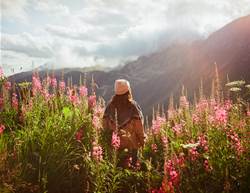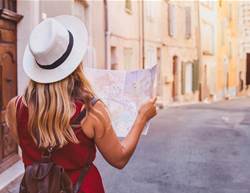Who said that an island holiday has to be all hammocks and palm trees? Taking it easy has its upsides, sure, but it’s much more fun to step out and get active, particularly when you’re breathing in that heady sea air.
Whatever your favourite activity – hiking, snorkelling, cycling or golfi ng – these magnificent Australian islands deliver plenty of outdoor adventure as well as the laidback charms of island life.
PICTURED MAIN: Rottnest Island/Tourism Western Australia




ROTTNEST ISLAND
Let’s start with some packing instructions. Bring your swimsuit, leave your bicycle at home. Yes, Rottnest Island, just off the coast of Perth, is a great place to go cycling – not least because it’s car free – but you don’t need to BYO wheels. You can hire everything you need right on the island. The good folk of Perth love to hop on the ferry for a day trip to Rottnest, or Rotto as it’s known locally.
Smart visitors plan to stay longer. There’s a lot to explore, starting with the 63 exquisite beaches and 20 bays that stud the coast. (You might also want to pack a snorkel, as the island’s reefs are home to colourful marine life; top spots include The Basin or Little Armstrong Bay.)
Other sights to take in as you cycle include the eye-catching salt lakes and the local wildlife. The island’s friendly quokkas are the star attraction and few people leave without snapping a quokka selfie. There are other animal encounters in store, too.
Cycle out to the West End of the island to the viewing platform at Cathedral Rocks: it’s the best place to check out Rotto’s resident fur seals. If you’re visiting in April, or between September and December, keep an eye out for the thousands of migrating humpback and southern right whales as they make their way along the coast. If the beaches, bays and wildlife aren’t enough of a lure, there’s another reason why Rottnest is so popular with cyclists – the hop-on hop-off bus that runs all the way out to West End and operates until 3pm daily, offering an easy out for tired legs.
Find out more: There are frequent ferries from Perth or Fremantle to Rottnest Island. Rates at the beachfront Samphire Rottnest start from $310 per night twin share. Visit samphirerottnest.com.au
PHOTO: Tourism Western Australia
LORD HOWE ISLAND
It may come as a surprise that a speck of land floating in the middle of the Pacific is heaven for hikers. Yet Lord Howe Island, a two-hour flight from Sydney, is just that. That’s partly to do with the things you won’t see as you hike: things such as highrise buildings and traffic jams (most of the 300 residents get around by bicycle; the speed limit is 25 kilometres per hour).
Mostly, however, it’s about the things you will see. Take the two-hour Malabar Walk, for instance. Starting near the tranquil Ned’s Beach, you climb through dense palm forests up to soaring cliffs that offer magnificent views of the island’s volcanic peaks, Mount Gower and Mount Lidgbird.
Between September and May, these cliffs are home to the largest breeding colony of tropical birds in the world – watching these long-tailed beauties wheel through the air is an attraction in itself.
Feel like pushing yourself a little further? Mount Gower offers a challenge even for active types. Allow eight hours for the return trip to the summit, which in some sections involves ropeassisted climbs; as the path is unmarked, you’ll need to go with a licensed guide. Apart from drinking in stellar views, you’ll get to explore ecosystems that few visitors ever encounter, including the moss forest on the highest slopes. Allow yourself some hikefree days: you’ll want to spend some time lazing on the beach, strolling through the kentia palm forest or snorkelling the southern-most coral reef in the world.
Be aware that only 400 visitors at a time are welcomed on the island, so plan well ahead.
Find out more: There are direct flights to Lord Howe Island from Sydney. All-inclusive rates at Pinetrees Lodge start from $2403 per person twin share for five nights in a Palm Room, including daily meals, airport transfers and a range of activities. See lordhoweisland.info
PHOTO: tom-archer.com
LADY ELLIOT ISLAND
Some people enjoy a morning run. On Lady Elliot Island, it’s the morning snorkel that kick-starts your day. Sitting like a full stop at the southern end of the Great Barrier Reef, this coral cay is known as one of the best spots on the whole reef for underwater encounters – and you can enjoy some of them simply by swimming out from the beach.
Always wanted to swim with a manta ray? Then grab a snorkel and flippers, wade into the water and swim out to the underwater outcrop Lighthouse Bommie. Mantas often circle the area, looking for cleaner fish that feed on the plankton caught in the manta’s jaw. It’s an extraordinary sight and it happens just 50 metres from shore.
The mantas aren’t the only underwater attraction at Lady Elliot. The unspoiled reef is home not just to spectacular coral formations – from colourful staghorns to huge brain and plate corals – but also about 1200 marine species. As David Attenborough once said, the beauty of the Great Barrier Reef is not just its incredible diversity, but also the fact that it’s all on display – like “the Harrod’s Christmas windows”, in his words. The best way to drink it all in, of course, is to strap on a scuba tank and dive into those clear waters. (If you have never dived before, the island offers courses for beginners.) You may find yourself swimming alongside giant potato cods or turtles, huge schools of trevally, or perhaps even a shy crayfish peering out from his bolthole.
You can learn more about these underwater wonders at the after-dinner lectures on offer at the Lady Elliot Island Eco Resort. Sustainability is built into every element of the resort, with fan cooling instead of air-conditioning and no telephone or television in rooms. Then again, not even Netflix’s most gripping series can compete with the drama and beauty of life on the reef.
Find out more: There are daily flights to the island from Brisbane and the Gold Coast. Rates start from $199 per person per night. Visit ladyelliot.com.au
KING ISLAND
It’s always tee time on King Island. Floating off the northwestern coast of Tasmania, just a 30-minute flight from Melbourne, this beautiful island has no fewer than three links golf courses and a population of just 1500. That means there’s plenty of room to swing your club – the only question will be, which exciting course will you tackle first? All of the island’s courses – Cape Wickham Links, Ocean Dunes Golf Course and King Island Golf and Bowling Club – are links courses, sculpted over the millennia by waves and winds. That makes them spectacularly scenic, not to mention fiendishly difficult. The greens flow up over headlands, skirt bays and wrap around rocky inlets.
At Cape Wickham Links, the eleventh hole is sometimes underwater; the beach at Victoria Cove provides the bunker for the final hole.
King Island offers lots of other outdoor adventures, too. With 1000 square kilometres to explore, there are beaches to stroll along, melaleuca forests to hike through, wetlands where you can go birdwatching, and towering cliffs from which you can gaze down at shipwrecks – all without ever encountering another person.
After you have worked up an appetite, there’s plenty of fresh produce to feast on, from local seafood and beef to cheese from the famed King Island Dairy.
If you’re in the mood to make an occasion of it, King Island now has its very own luxury retreat, the chic Kittawa Lodge, consisting of two elegant self-contained villas where you can hole up in comfort and gaze out to sea, knowing that the only creature to disturb your tranquillity may be a curious wallaby.
Find out more: There are flights to the island from Melbourne and Launceston. Rates at Kittawa Lodge start from $680 per night and include breakfast (two-night minimum). See kittawalodge.com










